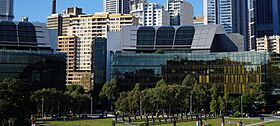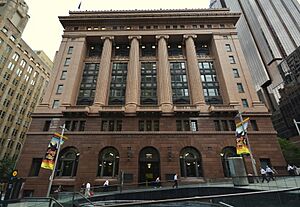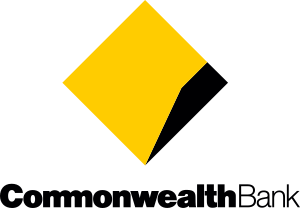Commonwealth Bank facts for kids
 |
|

Headquarters at Commonwealth Bank Place in Sydney
|
|
| Public | |
| Traded as |
|
| ISIN | ISIN: [https://isin.toolforge.org/?language=en&isin=AU000000CBA7 AU000000CBA7] |
| Industry | Financial services |
| Founded |
|
| Headquarters | Commonwealth Bank Place South, 11 Harbour Street,
,
Australia
|
|
Number of locations
|
|
|
Areas served
|
|
|
Key people
|
|
| Products |
|
|
Operating income
|
$21.17 billion (2024) |
| $9.8 billion (2024) | |
| Total assets | A$1.254 trillion (2024) |
| Total equity | A$73.08 billion (2024) |
| Members | 17.6 million (2024) |
|
Number of employees
|
53,000+ (2024) |
| Divisions |
CommBank divisions
Business Banking
Institutional Banking and Markets Retail Banking Services |
| Subsidiaries |
CommBank subsidiaries
ASB Bank
Bankwest Colonial First State CommInsure Commonwealth Securities Sovereign Limited |
| Capital ratio | 12.3% (2024) |
| Rating | AA- (2024) |
The Commonwealth Bank of Australia (CBA), often called Commonwealth Bank or CommBank, is a large Australian bank. It operates in many countries, including New Zealand, Asia, the United States, and the United Kingdom. The bank offers many different financial services. These include banking for everyday people and businesses, managing money, insurance, and investment services.
As of July 2024, Commonwealth Bank is the biggest Australian company listed on the Australian Securities Exchange. It owns other well-known brands like Bankwest and ASB Bank in New Zealand. The bank was started by the Australian Government in 1911. It became a fully private company in 1996. Commonwealth Bank is one of Australia's "big four" banks, along with National Australia Bank (NAB), ANZ, and Westpac.
In 2018, the bank faced challenges regarding its business practices. It worked to improve its culture and how it serves customers. In August 2024, Commonwealth Bank was listed as the 66th largest company in the world by its market value.
Contents
History of Commonwealth Bank
How the Bank Started (1911–1919)
The Commonwealth Bank of Australia was created by a law in 1911. This law was introduced by the government at the time. The bank was special because it offered both savings accounts and general banking services. It was also the first bank in Australia to have its deposits guaranteed by the federal government.
The first branch opened in Melbourne on July 15, 1912. The bank also worked with Australia Post to offer services through post office agencies. By 1913, it had branches in all six Australian states. In 1916, the bank moved its main office to Sydney. It also opened branches in New Guinea to support Australian soldiers.
Commonwealth Bank's Role as a Central Bank (1920–1959)
In 1920, the Commonwealth Bank started to take on duties like a country's main bank, also known as a central bank. It became responsible for printing Australian bank notes. In 1924, a board of directors was created to help manage the bank.
During the Great Depression in 1931, the bank's board disagreed with the government about how to handle the economy. This disagreement was a big event in Australian history.
The bank also expanded by taking over other savings banks in New South Wales and Western Australia. During World War II, the bank's operations in Papua New Guinea were paused. They restarted later to help with trade and local businesses.
After the war, the bank grew a lot. It opened many new branches across Australia. In 1951, it even opened a branch in the Solomon Islands.
By 1958-1959, people debated whether the bank should be both a central bank and a regular commercial bank. Because of this, the government decided to separate these roles. The Reserve Bank of Australia was created to be the central bank. Commonwealth Bank then focused only on being a commercial bank.
Growing and Changing (1960–1991)
In the 1970s, Commonwealth Bank started offering new services like insurance and travel. It also became more involved in international banking.
The bank helped Australia switch to decimal currency in 1966. It also started using computers to manage its records. In 1974, Commonwealth Bank launched Bankcard, Australia's first credit card. Later, it also offered MasterCard and Visa cards.
As Papua New Guinea became independent in 1974, the bank handed over its operations there to a new local bank. In 1989, Commonwealth Bank bought a large part of ASB Bank in New Zealand. In 1991, it also acquired the State Bank of Victoria.
Becoming a Private Company (1991–Present)

Between 1991 and 1996, the Australian Government sold all its shares in Commonwealth Bank. This made it a fully private company.
The bank continued to grow by merging with other companies. In 2000, it merged with Colonial Limited. This expanded its services in areas like funds management and insurance. It also gained full ownership of ASB Bank in New Zealand.
Commonwealth Bank also looked for opportunities in Asia. It took full ownership of PT Bank International Indonesia in 2000, renaming it PT Bank Commonwealth. In 2005, it partnered with Chinese banks and opened an office in Bangalore, India.
In 2008, Commonwealth Bank bought Bankwest and Wizard Home Loans. This helped it offer more home loans and insurance.
In 2018, the bank faced a public inquiry into its past actions. It admitted to some issues and worked to improve its conduct and how it serves customers. The bank paid a settlement for some past practices. In 2023, it sold its shares in PT Bank Commonwealth in Indonesia.
Commonwealth Bank Headquarters
Commonwealth Bank has had several main offices over the years. It started in Melbourne, then moved to Martin Place in Sydney. In recent years, the bank has moved its main operations to new buildings in Darling Harbour in Sydney.
As of October 2024, most Commonwealth Bank staff work from locations like CBP South, CBP North, The Foundry, Axel, or CBS in Sydney.
How the Bank is Organized
Customer Services
This part of the bank helps everyday people and small businesses. It offers bank accounts and loans.
Business and Institutional Services
This section helps larger businesses and big organizations. It provides services for global markets and private banking customers.
Wealth Management
Wealth Management helps people manage their money for the future. This includes things like superannuation (retirement savings), insurance, and financial advice.
Bank Leaders
The Commonwealth Bank has had many important leaders throughout its history. These leaders have guided the bank through different times and changes.
| Order | Name | Title | Term start | Term end | Time in office |
|---|---|---|---|---|---|
| 1 | Sir Denison Miller KCMG | Governor | June 1912 | June 1923 | 11 years, 29 days |
| 2 | James Kell | June 1923 | October 1926 | 3 years, 122 days | |
| 3 | Sir Ernest Riddle | October 1926 | February 1938 | 11 years, 121 days | |
| 4 | Sir Harry Sheehan CBE | March 1938 | March 1941 | 3 years, 0 days | |
| 5 | Hugh Traill Armitage CMG | July 1941 | December 1948 | 7 years, 183 days | |
| 6 | Dr H. C. Coombs | January 1949 | January 1960 | 11 years, 0 days | |
| 7 | Ernest Richardson CBE | Managing Director | January 1960 | March 1965 | 5 years, 89 days |
| 8 | Sir Bede Callaghan CBE | May 1965 | August 1976 | 11 years, 92 days | |
| 9 | Sir Ronald Elliott | August 1976 | August 1981 | 5 years, 0 days | |
| 10 | Vern Christie AO | August 1981 | March 1987 | 5 years, 212 days | |
| 11 | Donald Sanders AO CB | March 1987 | December 1990 | 3 years, 275 days | |
| Chief Executive Officer | January 1991 | June 1992 | 1 year, 181 days | ||
| 12 | David Murray AO | June 1992 | September 2005 | 13 years, 92 days | |
| 13 | Sir Ralph Norris KNZM | September 2005 | November 2011 | 6 years, 29 days | |
| 14 | Ian Narev | December 2011 | April 2018 | 6 years, 128 days | |
| 15 | Matt Comyn | April 2018 | incumbent | 7 years, 252 days |
International Presence
Commonwealth Bank has a presence in several countries around the world:
- It has retail banks in New Zealand (ASB Bank) and Indonesia (PT Bank Commonwealth).
- It has investments in banks in China and Vietnam.
- There are Commonwealth Bank branches in major cities like London, New York City, Tokyo, Hong Kong, and Singapore.
- It also has joint ventures for life insurance in Indonesia and China.
- The bank has a Global Capability Center in Bangalore, India.
Products and Services
Commonwealth Bank is Australia's largest retail bank. It offers many products and services to its customers. These include:
- Loans for homes and other needs.
- Credit cards.
- Accounts for everyday spending and savings.
- It has the biggest network of branches and ATMs in Australia.
- The bank also helps people who are planning to move to Australia.
NetBank Online Banking
Commonwealth Bank offers online banking through a service called NetBank. This allows customers to manage their money from a computer or phone. You can transfer funds, check your accounts, and set savings goals. NetBank also has a mobile app for iOS and Android devices.
Beem It App
Beem It is a mobile app that lets people send money instantly to each other. It was owned by Commonwealth Bank, NAB, and Westpac, and later sold to Eftpos Australia. You can use it to pay, transfer, request, or split money with friends, no matter which bank they use.
Bank Subsidiaries
Commonwealth Bank owns several other companies, called subsidiaries:
Australia
- Bankwest
- Colonial First State
- CommInsure (for insurance)
- Commonwealth Securities (for investing)
Asia Pacific
- PT Bank Commonwealth (Indonesia)
New Zealand
- ASB
Türkiye
- TR Commbiz (Turkey)
Sponsorships
Commonwealth Bank supports many sports and events:
- It has sponsored Cricket Australia since 1987, including for women's cricket. This partnership will end in June 2025.
- Since April 2021, Commonwealth Bank has partnered with Football Australia. It sponsors the women's national football teams, known as the Commonwealth Bank Matildas, Young Matildas, and Junior Matildas. This partnership is extending to include the men's national teams from September 2025.
- In November 2022, Commonwealth Bank became an official supporter for the 2023 FIFA Women's World Cup.
- The bank is also the current sponsor for Western Sydney Stadium since 2021.
Profits by Year
| Year | Profit | |
|---|---|---|
| 2010 | ||
| 2011 | ||
| 2012 | ||
| 2013 | ||
| 2014 | ||
| 2015 | ||
| 2016 | ||
| 2017 | ||
| 2018 | ||
| 2019 | ||
| 2020 | ||
| 2021 | ||
| 2022 | ||
| 2023 |
Images for kids
See also
 In Spanish: Commonwealth Bank para niños
In Spanish: Commonwealth Bank para niños
- Australian Cricket Academy
- Banking in Australia
- Commonwealth Bank Series
- Commonwealth Bank Trophy
- List of banks in Australia
- List of banks in Oceania
- Reserve Bank of Australia
- State Bank of New South Wales
- State Bank of Victoria






